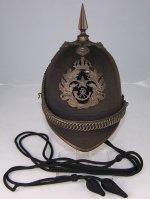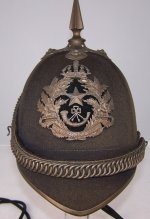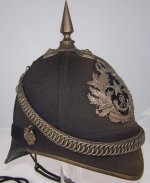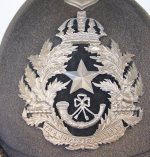RoyalScotsVols
Member
The regular Cameronians (Scottish Rifles) regiment was formed in 1881 under the Childers Reforms by the amalgamation of the 26th Cameronian Regiment and the 90th Perthshire Light Infantry. It can trace its roots to that of the Cameronians, later the 26th of Foot, who were raised in 1689. The 1881 amalgamation coincided with the Cameronians' selection to become the new Scottish Rifles, the only regiment of rifles amongst the Scottish infantry. After the amalgamation, the 1st Battalion preferred to be known as "The Cameronians" while the 2nd preferred to be known as "The Scottish Rifles".
The 3rd and 4th Militia battalions were then formed from the former 2nd Royal Lanark Militia. The 4th battalion was embodied in December 1899, for service during the Second Boer War, and 600 officers and men embarked for South Africa in late February 1900. The 3rd battalion was embodied in May 1900 also for service in the same war with a further 600 men embarked for South Africa in April 1901 and returned in June 1902 following the end of hostilities.
Pictured is a Militia officers helmet in dark rifle green cloth with darkened helmet fittings and fitted with cap lines which is unusual for a Home Service pattern helmet. The helmet plate features a mullet over a strung bugle, thistle sprays either side with a sphinx and china dragon and 'The Scottish Rifles' scroll below. The plate bears the Guelphic pattern crown in common with many units of the Rifle Brigade. The plate differs from that worn by a regular officer in that the regiment's battle honours are not marked upon the leaves of the sprays and the plinths on which the sphinx and dragon sit are of a different pattern.
As the Guelphic crown is less frequently seen, it can cause confusion amongst collectors. It was used during the Victorian period with the connection being Prince Albert, Queen Victoria's husband. Prince Albert was German and his crown was the Guelphic crown from the Dukes of the House of Hanover of which he was a member, as were the British Royal family. The crown on the Cameronian helmet plate is well rendered and closely matches that of the Royal Guelphic Order but some renditions on other badges can appear confusingly close to the Tudor (frequently referred to as 'King's') pattern.




The 3rd and 4th Militia battalions were then formed from the former 2nd Royal Lanark Militia. The 4th battalion was embodied in December 1899, for service during the Second Boer War, and 600 officers and men embarked for South Africa in late February 1900. The 3rd battalion was embodied in May 1900 also for service in the same war with a further 600 men embarked for South Africa in April 1901 and returned in June 1902 following the end of hostilities.
Pictured is a Militia officers helmet in dark rifle green cloth with darkened helmet fittings and fitted with cap lines which is unusual for a Home Service pattern helmet. The helmet plate features a mullet over a strung bugle, thistle sprays either side with a sphinx and china dragon and 'The Scottish Rifles' scroll below. The plate bears the Guelphic pattern crown in common with many units of the Rifle Brigade. The plate differs from that worn by a regular officer in that the regiment's battle honours are not marked upon the leaves of the sprays and the plinths on which the sphinx and dragon sit are of a different pattern.
As the Guelphic crown is less frequently seen, it can cause confusion amongst collectors. It was used during the Victorian period with the connection being Prince Albert, Queen Victoria's husband. Prince Albert was German and his crown was the Guelphic crown from the Dukes of the House of Hanover of which he was a member, as were the British Royal family. The crown on the Cameronian helmet plate is well rendered and closely matches that of the Royal Guelphic Order but some renditions on other badges can appear confusingly close to the Tudor (frequently referred to as 'King's') pattern.




Last edited:
